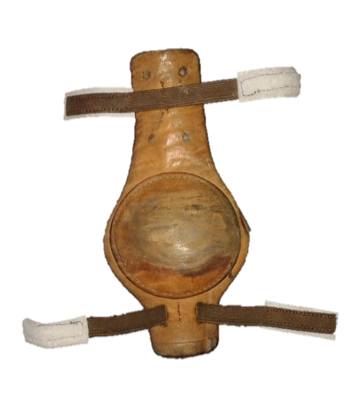Muffling the bells
The sound of half-muffled tower bells is unmistakable. In Rounds it’s like a normal descending scale followed by an eerie echo of that sound. This is why bells are usually rung half-muffled in mourning: for funerals and other solemn occasions such as on Remembrance Day, or to mourn the old year before the New Year is rung in. Some churches ring half-muffled during Lent.
To make this sound, a ‘muffle’ is fitted to each bell. A muffle is simply a pad of resilient material attached to the ball of the clapper in such a way that the impact of the clapper against the sound bow is greatly reduced. This has the effect that, instead of hearing the ‘strike note’ of the bell, we hear the ‘hum note’ instead.
Complicated? Well, all you need to know is that the sound of a tower bell is actually composed of five (or more) different notes which are all tunable by a skilled lathe operator in a bell foundry so as to produce a pleasant tone. The muffle simply causes these notes to be heard in a different ratio and volume.
Muffles are traditionally made of leather. Leather has always been a widely available material which is easily worked and will survive the repeated impacts it receives and which provides a suitable degree of damping to make an appropriate sound. It will give many years of service if kept supple with the sparing use of dubbin.
A muffle can be anything from a simple square of thick leather tied on at the corners with leather boot-laces threaded through punched holes, to a carefully shaped, multi-layer pad that can be rapidly positioned with straps and industrial Velcro. I’ve even heard of gardening knee-pads being used in an emergency!
Because Called Changes take effect at handstroke, a muffle is usually placed so that the handstroke sounds ‘open’ and the backstroke sounds the muffled echo. This means that the muffle has to be placed on the side of the clapper away from the rope and the ground-pulley. Once fitted, check that the muffle cannot rotate and that the muffle ties cannot come between the clapper and the bell – otherwise you will have a bell muffled on both strokes until the tie breaks under the repeated impacts and the muffle falls off completely! Also be aware that if a bell goes up ‘wrong’ the handstroke will be muffled instead of the backstroke and you will have to correct that before ringing. Don’t leave it until the last minute if you’ve not fitted them before. Practise it now!
Fitting a muffle to just one side of the clapper is what we mean by half-muffled. Fully muffled bells (on both sides, except for the tenor) are considered reserved for the death of the Monarch, the Bishop of the diocese, or the incumbent Vicar.
For safety reasons, muffles should always be fitted and removed with the bells down. Work in pairs, and take precautions to ensure that no-one in them ringing room will try to pull on a rope while you’re working underneath the bells.
Mike Rigby, ART Teacher and Tower Captain at Lighthorne, Warks